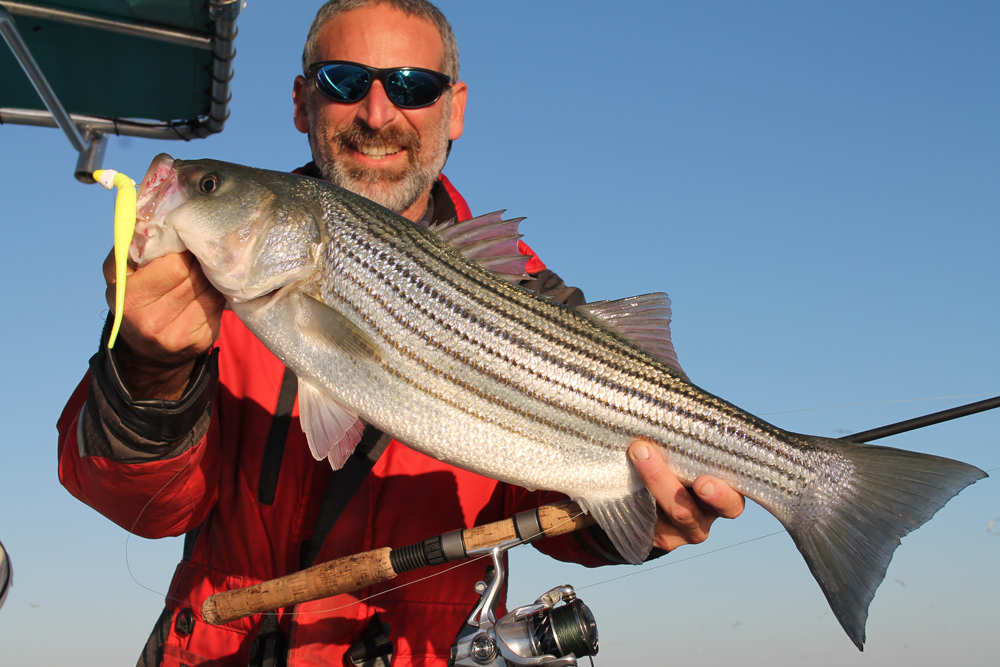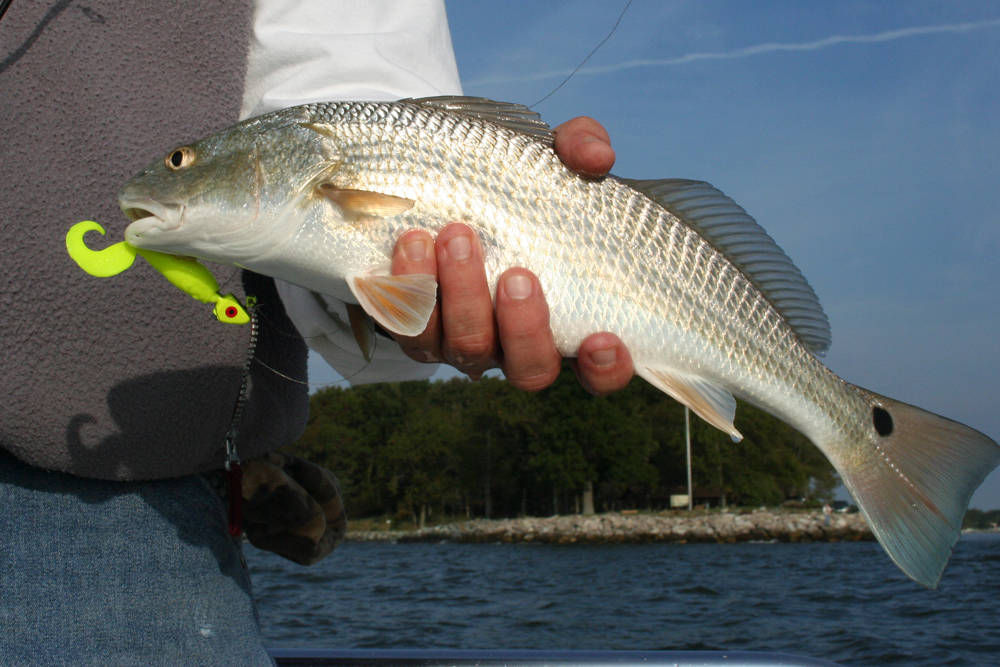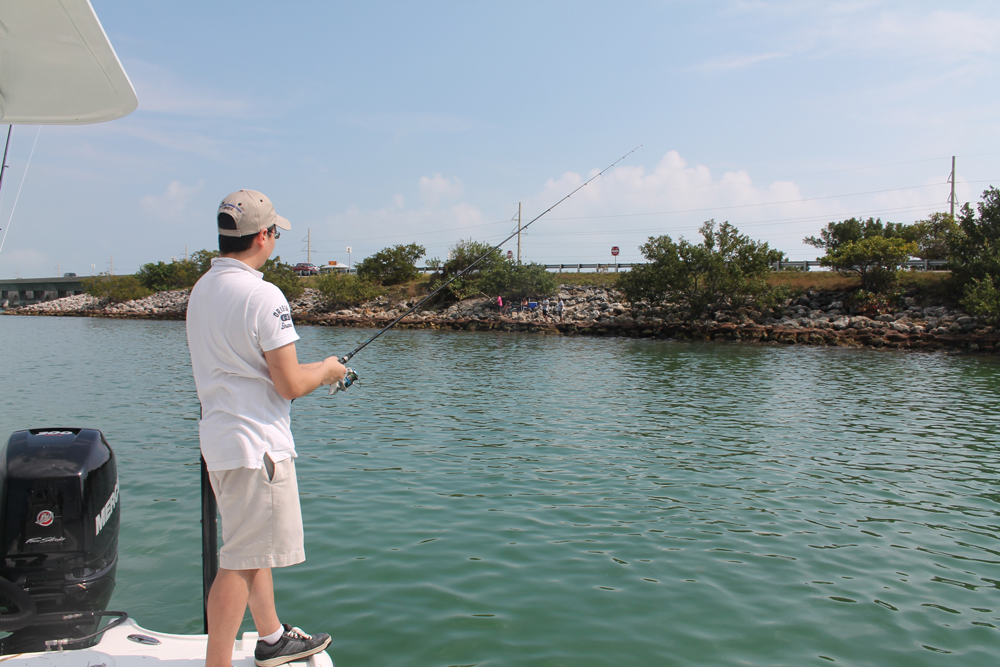Whether you’re prowling the shoreline of a tributary, working a rip-rapped stretch of the banks of the Bay, or casting to the sod banks of a Tangier Sound island, catching stripers on light tackle in the shallows can be every bit as exciting and productive as casting to a bonefish flat in the Bahamas. You say you disagree? Let’s see who will maintain that position after a 40-inch striper blasts a topwater plug in two feet of water. Truth be told, we’re a bit jaded here in Chesapeake Country, where we enjoy world-class striper fishing at one point or another almost every season. And I’ve had more than one highly-experienced and well-travelled out-of-town angler gasp, grin, and gape at one of our beautiful rockfish as it goes on the attack in skinny water. Before we look at some specifics in detail, check out this short shallow water how-to video we shot, with the folks from Angler's Sport Center.
On Top of Topwater Fishing
Yes, a 40-incher in the shallows is the exception, not the rule. But the size of the stripers you’ll tie into in shallow water is quite surprising, especially when you’re a mile or three up inside a tributary. And one of the best ways to target larger stripers in the shallows is also one of the most exciting: working topwater lures. For some reason—I have no idea why—the bigger fish in an area often seem to attack topwater before they’ll hit jigs. That said, soft plastics like BKDs, Fin-S, Bust ‘Ems, and Zooms do tend to rack up higher numbers. A big part of this has to do with the hook-up ratio (topwater strikes have a low strike-to-hookup ratio, while jigs have a high one) but if you want to target the largest fish possible, topwater is the way to go.

Top picks for lures include the Bomber Badonk-A-Donk, Yo-Zuri Pencil and Hydro Pencils, Strike King Sexy Dawgs, Heddon Spooks, and Rapala Skitters. Generally speaking for the larger stripers you’ll want to choose something between five and eight inches. Color choices will naturally vary from day to day, but as a rule of thumb are less important when it comes to topwater as the fish will be looking up and seeing only the belly of the lure. White undersides are usually best, black works well in very low light, and the many amazingly life-like patterns on the sides and backs of some of these lures seem have a much bigger affect on you and me in the tackle shop than they do on the fish. The same cannot be said of rattles, which definitely make a difference many days. In all cases these plugs come with treble hooks which will do a lot of damage to throw-backs, and when a fish shakes at just the wrong moment, your hands and fingers. Replacing them with singles will reduce the number of hook-ups, but will also be doing the fish and perhaps yourself a big favor.
You’ll notice that all of the topwater lures called out here share one thing in common: they’re “walkers” designed for a walk-the-dog retrieve, not “chuggers” that have a hollowed-out face to create a pop and lots of splashing as they move through the water. In my experience, out in open water when fish are busting the surface or are feeding up top, chuggers and poppers do great. But in the calm waters of the shallows, a more subtle walking-the-dog retrieve seems to be the ticket.
Walking-the-dog in a nutshell: After casting out keep your tip low and rhythmically pump it as you reel at a steady pace, causing the lure to zig-zag back and forth. If a fish blasts it and misses, a common event, do not stop—that’s a sure way to end the fish’s interest. Instead keep the lure moving, and the fish will often return and keep swiping at the lure.
Fishing Jigs in the Shallows
Topwater success is often directly related to the height of the sun: the higher in the sky it gets, the less effective topwater becomes. Once light levels are high working a jig or sub-surface plug is usually the better move (cloudy and rainy days are an exception).
As far as those jigs go, soft plastics of five to seven inches rigged on a quarter-ounce head are a top producer in the shallows. Chartreuse and white are the go-to colors, but only experimentation will tell you exactly which color is going to be best on any given day. Anglers who are less experienced at working a jig to get the best action are better served by opting for either paddle-tail or twister-tail plastics, which have plenty of action as they move through the water without any added input from the angler.

As far as sub-surface lures in the shallows goes, a Rat-L-Trap is going to be extremely tough to beat. These plugs do seem to call in fish from afar and are highly effective. That said, their treble hooks, like those of most plugs, are murder on the fish.
Whatever lure you choose, it should be cast as close as possible to shoreline structure. The stripers are hunting for minnow, crabs, grass shrimp, and other critters hiding among rocks or pilings, and the fish’s attention is fixed on the very place where water and structure meet. Lures that drop down six inches from this intersection will get smacked, while those that fall six feet short will often go untouched—so cast as close to the structure as you dare. When using lead-head jigs, you’ll also want to keep your retrieves relatively fast and your tip high, to prevent snags in the shallow water. If there’s a decent drop-off where you’re fishing, as soon as you’re confident the lure has passed beyond the snagging danger zone, you can drop your tip and/or slow down, to get the lure working a bit deeper.
Just what structure should you be shooting for? The list of fish-attracting shoreline items includes rip-rap, boathouses and piers, points, cuts and small creek-mouths, and trees laying in the water. These are listed in order of my personal favorites, but the best spots are never just one of these items but a combination of them. Rip-rap on a point, for example, or a tree laying in the water right next to the mouth of a cut. Also note that boathouses and piers can sometimes out-produce other hotspots when the sun is high in the sky, as fish will sometimes hide in their shade. The best spots also have relatively close access to deeper water. You’ll catch plenty of nice fish from hotspots in just a foot or two of water, but if a potential hotspot doesn’t have 10 or 12 feet of water within 50 or 60 yards, it probably isn’t going to produce any monsters.
All of that said, serious skinny water sharpies will invest some time in working their way down a shoreline, hitting pier after pier and one rip-rapped area after the next. You will discover that certain specific piers inexplicably hold fish, even though they look no better or worse than any of the others running down a shoreline. Also make sure to pay special attention to piers with large lights on them. The lights invariably attract fish at night, and they often will stick around the same pier for a while after the sun comes up.

Stealth Fishing the Shallows
When you’re fishing in skinny water, be it the Florida flats or the edges of a Chesapeake tidewater creek, keeping sound levels to a minimum is incredibly important. A person yelling loudly (Darn! I missed a bite!) is enough to spook every fish within casting range. Letting a fiberglass hatch slam closed, dragging a tacklebox or an anchor across the deck, or dropping a lead weight on the deck are all also fish-spookers.
The affects of motors are a point of debate, but I’ve recorded and measured the sound levels of engines underwater with a hydrophone and found that their sound levels are essentially pretty similar underwater to what you hear standing on your boat. A modern four-stroke at idle creates virtually no noise, and the dribbling sound of water streaming from the tell-tale is actually louder than the engine itself. But a two-stroke does make an audible chatter underwater. And in neutral, a two-stroke is actually louder than it is when in gear, producing a metal-on-metal clacking and clanging that carries right through the water. In either case most of the time (the exception being outboards swinging Yamaha’s Shift Dampening System propellers) the “clunk” of an engine being shifted into gear is quite loud underwater. And all motors—electric included—create prop noise when they’re in gear, the significance of which is directly related to rpm. In fact, a 70-lb. thrust electric trolling motor going full-blast is about the same volume as a four-stroke spinning the prop at around 1700 or 1800 rpm (though this can and does change with the type of propeller and the number and shape of its blades).
The bottom line? When you’re fishing the shallows, the stealthier you are, the more fish you’ll catch. Simply being aware of this fact and acting accordingly is the most important thing.
-by Lenny Rudow
Check out 5 Hotspots for Shallow Water Striper Fishing, where we’ll cover the where-to of specific shallow-water hotspots in the Chesapeake.